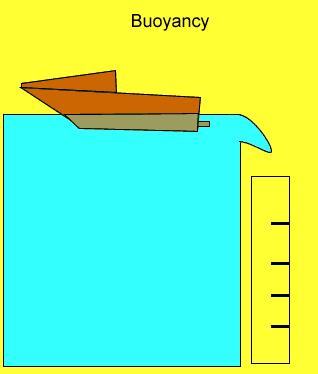
You may wish to familiarize yourself with the concept of buoyancy before continuing.
The pot-pot
boat floats because of the principle of flotation. This principle states
that:
"A floating object displaces(pushes aside) a weight of fluid
equal to its own weight". Boats must be built so that they
displace a weight of water equal to their own weight. If they displace
a weight of water less than their own weight they will sink. The force
with which the displaced water pushes up on the boat is called the buoyant
force. Lets see what the buoyant force of the Pot-Pot boat is and use
this knowledge to calculate the maximum weight of fuel that can be carried
by our Pot-Pot boat.
Firstly, we need to find out the maximum weight that our Pot-Pot boat can displace without sinking.
Step 1 - Fill a beaker to the brim with water.
Step 2 - Place the Pot-Pot boat on the surface so that it just floats.
Step3 - Place a small measuring cylinder under the lip of the larger beaker so that water, flowing from the large beaker, will run into it. Measure the weight of this measuring cylinder first.
Step 4 - Gently push down on the boat until the water is just about to flow into the hull of the boat, as shown in the animation on the right.
Step 5 - Weigh the cylinder with its water content.

|
|
Weight
of measuring cylinder
|
Weight
of measuring cylinder and water
|
Weight
of water
|
|
1
|
|
|
|
|
2
|
|
|
|
|
3
|
|
|
|
| Average
weight of cargo (add weight of water for 1,2 and 3 and divide by 3) |
|
||